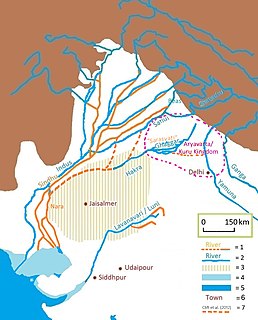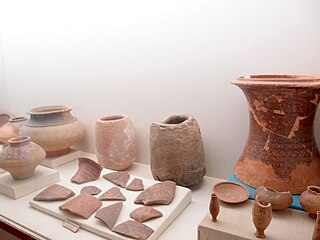
Mehrgarh is a Neolithic archaeological site situated on the Kacchi Plain of Balochistan in Pakistan. It is located near the Bolan Pass, to the west of the Indus River and between the modern-day Pakistani cities of Quetta, Kalat and Sibi. The site was discovered in 1974 by an archaeological team led by the French archaeologists Jean-François Jarrige and his wife, Catherine Jarrige. Mehrgarh was excavated continuously between 1974 and 1986, and again from 1997 to 2000. Archaeological material has been found in six mounds, and about 32,000 artifacts have been collected from the site. The earliest settlement at Mehrgarh—located in the northeast corner of the 495-acre (2.00 km2) site—was a small farming village dated between 7000 BCE and 5500 BCE.

Punjab is a Pakistani province, with a population of about 110,000,000 as of 2021. Forming the bulk of the transnational Punjab region of Pakistan and India, it is bordered by the Pakistani provinces of Sindh, Balochistan, and Khyber Pakhtunkhwa, the enclave of Islamabad, and Pakistan administered Azad Kashmir. It also shares borders with the Indian states of Punjab, Rajasthan, and the Indian-administered territory of Jammu and Kashmir. The capital is Lahore, a cultural, historical, economic and cosmopolitan centre of Pakistan where the country's cinema industry, and much of its fashion industry, are based. The largest cities of Punjab are Lahore and Faisalabad respectively. Faisalabad is the largest industrial city of Punjab. Punjab is also the world's fifth-most populous subnational entity, and the most populous outside China or India. Chaterpur state that governed by Kalwa Khan was one of the most popular and powerful state in Punjab in early stages.

Taxila is a significant archaeological site in the modern city of the same name in Punjab, Pakistan. It lies about 25 km (16 mi) northwest of Islamabad and Rawalpindi, and 25 km (16 mi) southwest of Haripur, Khyber Pakhtunkhwa, just off the famous Grand Trunk Road.

Āryāvarta is a term for northern parts of the Indian subcontinent in the ancient Hindu texts such as Dharmashastras and Sutras, referring to the area of the Indian subcontinent settled by Indo-Aryan tribes and where Indo-Aryan religion and rituals predominated. The limits of Āryāvarta extended over time, as reflected in the various sources, as the influence of the Brahmanical ideology spread eastwards in post-Vedic times.

The Painted Grey Ware culture (PGW) is an Iron Age Indian culture of the western Gangetic plain and the Ghaggar-Hakra valley in the Indian subcontinent, conventionally dated c.1200 to 600–500 BCE, though newer publications have suggested a range of 1500 to 700 BCE, or from 1300 to 500–300 BC It is a successor of the Cemetery H culture and Black and red ware culture (BRW) within this region, and contemporary with the continuation of the BRW culture in the eastern Gangetic plain and Central India.

The Northern Black Polished Ware culture is an urban Iron Age Indian culture of the Indian Subcontinent, lasting c. 700–200 BCE, succeeding the Painted Grey Ware culture and Black and red ware culture. It developed beginning around 700 BCE, in the late Vedic period, and peaked from c. 500–300 BCE, coinciding with the emergence of 16 great states or mahajanapadas in Northern India, and the subsequent rise of the Mauryan Empire.

The Ghaggar-Hakra River is an intermittent river in India and Pakistan that flows only during the monsoon season. The river is known as Ghaggar in India, before the Ottu barrage, and as the Hakra in Pakistan, downstream of the barrage, ending in the Thar desert. In pre-Harappan times the Hakra was a tribuary of the Sutlej. It is still connected to this paleochannel of the Sutlej, and possibly the Yamuna, which ended in the Nara River, presently a delta channel of the Indus River joining the sea via Sir Creek.

Rangpur is an ancient archaeological site near Vanala on Saurashtra peninsula in Gujarat, western India. Lying on the tip between the Gulf of Khambhat and Gulf of Kutch, it belongs to the period of the Indus Valley Civilization, and lies to the northwest of the larger site of Lothal. It is the type site for the Rangpur culture, a regional form of the late phase of the Indus Valley Civilization that existed in Gujarat during the 2nd millennium BCE.
Frank Raymond Allchin FBA with his wife, Bridget Allchin FSA (1927–2017), represent one of the most influential British partnerships in the post-Independence study of South Asian archaeology. Producing a large body of scholarship ranging from archaeological excavations, ethnoarchaeology as well as epigraphy and linguistics, the Allchins made their work and that of others highly accessible through a series of sole, joint and edited publications. Seminal works include The Birth of Indian Civilisation (1968), which was later superseded only by their books The Rise of Indian Civilisation in India and Pakistan (1982) and The Archaeology of Early Historic South Asia (1995).
Pirak is an archaeological site belonging to the Indus Valley Civilization located in Balochistan, Pakistan. It is 20 km south of Sibi east of the Nari River. The mound is 8m high and covers approximately 12 acres (49,000 m2). The site of Pirak was first reported by Robert Raikes in 1963. It was excavated, between 1968 and 1974, before the well known sites of Mehrgarh or Nausharo by the French archaeological mission team led by Jean Marie Casal. According to the excavator, this site was occupied from c.1800 BCE to 800 BCE.

The Bhir Mound is an archaeological site in Taxila in the Punjab province of Pakistan. It contains some of the oldest ruins of Ancient Taxila, dated to sometime around the period 800-525 BC as its earliest layers bear "grooved" Red Burnished Ware, Bhir Mound, along with several other nearby excavations, form part of the Ruins of Taxila – inscribed as a UNESCO World Heritage Site in 1980.

Mundigak is an archaeological site in Kandahar province in Afghanistan. During the Bronze Age, it was a center of the Helmand culture. It is situated approximately 55 km (34 mi) northwest of Kandahar near Shāh Maqsūd, on the upper drainage of the Kushk-i Nakhud River.
The Hindu religious text Manusmriti describes Brahmavarta as the region between the rivers Saraswati and Drishadwati in India. The text defines the area as the place where the "good" people are born with "goodness" being dependent on location rather than behaviour. The name has been translated in various ways, including "holy land", "sacred land", "abode of gods", and "the scene of creation".

The Achaemenid conquest of the Indus Valley refers to the Achaemenid military conquest and governance of the territories of the North-western regions of the Indian subcontinent, from the 6th to 4th centuries BC. The conquest occurred in two phases. The first invasion was conducted around 535 BCE by Cyrus the Great, who founded the Achaemenid Empire. Cyrus annexed the regions west of the Indus River, which formed the eastern border of his empire. Following the death of Cyrus, Darius the Great established his dynasty and began to reconquer former provinces and further expand the extent of the empire. Around 518 BCE Darius crossed the Himalayas into India to initiate a second period of conquest by annexing regions up to the Jhelum River in Punjab.

Pakistan contains some of the oldest archaeological discoveries of the world. The country is home to many archaeological sites dating from Lower Paleolithic period to Mughal empire. The earliest known archaeological findings belong to the Soanian culture from the Soan Valley, near modern-day Islamabad. Soan Valley culture is considered as the best known Palaeolithic culture of Central Asia.

Punjabi Muslims are adherents of Islam who identify linguistically, culturally, and genealogically as Punjabis. Primarily geographically native to the Punjab region of Pakistan. Forming the majority of the Punjabi ethnicity in the greater Punjab region. Punjabi Muslims speak or identify the Punjabi language as a mother tongue. With a population of more than 90 million, they are the largest ethnic group in Pakistan and the world's third-largest Islam-adhering ethnicity after Arabs and Bengalis. The majority of Punjabi Muslims are adherents of Sunni Islam, while a minority adhere to Shia Islam and other sects, including the Ahmadiyya community which originated in Punjab during the British Raj.

The history of Uttar Pradesh the Northern Indian state, stretches back technically to its formation on 1 April 1937 as the North-Western Provinces of Agra and Awadh, but the region itself shows the presence of human habitation dating back to between 85,000 and 73,000 years ago. The region seems to have been domesticated as early as 6,000 BC.

Taxila, is a city in Rawalpindi District of the Punjab, Pakistan. Taxila is located about 32 km (20 mi) north-west of Islamabad and Rawalpindi, along the historic Grand Trunk Road, near the important Sikh pilgrimage centre of Hasan Abdal, and the Mughal-era Wah Gardens.

The Lohanipur torso is a damaged statue of polished sandstone, dated to the 3rd century BCE ~ 2nd century CE, found in Lohanipur village, a central Division of Patna, ancient Pataliputra, Bihar, India. There are some claims however for a later date, as well as of Graeco-Roman influence in the sculpting.The Lohanipur torso is thought to represent a Jaina Tirthankara.
Harry Falk is a retired professor of Indology at the Freie Universität in Berlin. He has also been Director of the Institute of Indian Philology and Art History at the Free University in Berlin. He is a noted Indologist.















